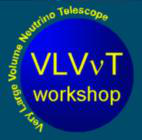Orateur
Dr
Simona Toscano
(IFIC - Valencia)
Description
In this contribution we review the concepts put forward for the time calibration and positioning systems of the future KM3NeT neutrino telescope in the Mediterranean Sea. Even though the final layout of the detector, its mechanical structures and the light detection technologies to be used are not yet defined, much progress has been made in clarifying the possible technologies available for calibration and positioning. Concerning time calibration, we review the different concepts proposed, namely Optical Beacons (LED and Laser), fibres or copper cables, K40, and an internal clock signal. For positioning, in order to deal with longer distances and keep the cost under control the use of acoustic signals with lower frequency components in combination with cheaper hydrophones is being investigated. The need and use of compasses and tiltmeters is strongly correlated to the mechanical structure chosen. For absolute positioning, three methods are being considered: acoustics from navigation, a sea surface array for shower coincidences and the shadowing of the moon. We will summarize the advantages and drawbacks of each proposed solution and their suitability depending on the different detector schemes.
Auteur
Dr
Simona Toscano
(IFIC - Valencia)
Co-auteurs
Dr
Jean-Pierre Schuller
(CEA-Saclay)
Dr
Juan Jose Hernandez-Rey
(IFIC - Valencia)
Dr
Lee Thompson
(University of Sheffield)
Dr
Manuel Cabo-Bou
(IGIC - UPV Valencia)
Dr
Marco Circella
(INFN - Sez. Bari)
Dr
Miguel Ardid
(IGIC - UPV Valencia)

